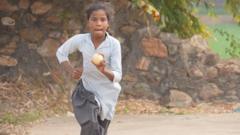As a regular child from a rural region of Rajasthan, 10-year-old Sushila Meena's life underwent a dramatic transformation when cricket legend Sachin Tendulkar shared a video showcasing her exceptional bowling skills on social media. Many viewed the clip, with Tendulkar noting that her bowling style bore similarities to noted Indian bowler Zaheer Khan, known for his skillful technique.
The video garnered millions of views, thrusting Sushila into the limelight. Yet, intriguingly, the young girl remains unaware of who Tendulkar is since her family does not own a television, and they do not follow cricket. Despite this, she expresses gratitude for the recognition, and her new fame has made her the center of attention in her village, garnering admiration from politicians, social activists, and even family members.
Sushila's character transforms when she steps onto the cricket field with a rubber ball; her competitive spirit emerges, expressing only determination to excel in the game. Her friend Asha, acting as the opposing batter, acknowledges the challenges posed by Sushila's bowling technique, revealing its unpredictability.
While her mother, Shantibai, beams with pride at Sushila's achievements, she also faces criticism from some community members who question the family’s decision to allow her to pursue sports instead of adhering to traditional roles expected of girls. Unfazed by the detractors, Shantibai affirms her commitment to support Sushila's passion for cricket.
The school's cricket program, launched by teacher Ishwarlal Meena in 2017, provides an outlet for students, with Mr. Meena self-educating through online resources to coach students. His efforts have led to a growing interest in cricket among students. Sushila is not an isolated case; another student, Renuka Pargi, previously gained fame for her batting and has since applied to a cricket academy in Jaipur.
Despite the success stories, the infrastructure for cricket and education in Sushila's village remains inadequate. Local officials have acknowledged the need for improvements but have yet to implement any substantial changes. The school currently only offers education up to the fifth grade, raising concerns about the continual development of budding athletes like Sushila.
Even as Sushila receives gifts and acknowledgment, she still lacks essential equipment for serious cricket practice, reinforcing the uncertainty surrounding her future in the sport. The village is abuzz with curiosity about whether her viral fame will translate into lasting opportunities or fade as quickly as the fleeting gifts she receives.
In this narrative of unexpected stardom, Sushila's story illustrates the broader social context of sporting potential, urging reflection on the disparities that young athletes in rural India face amidst rising digital visibility.























